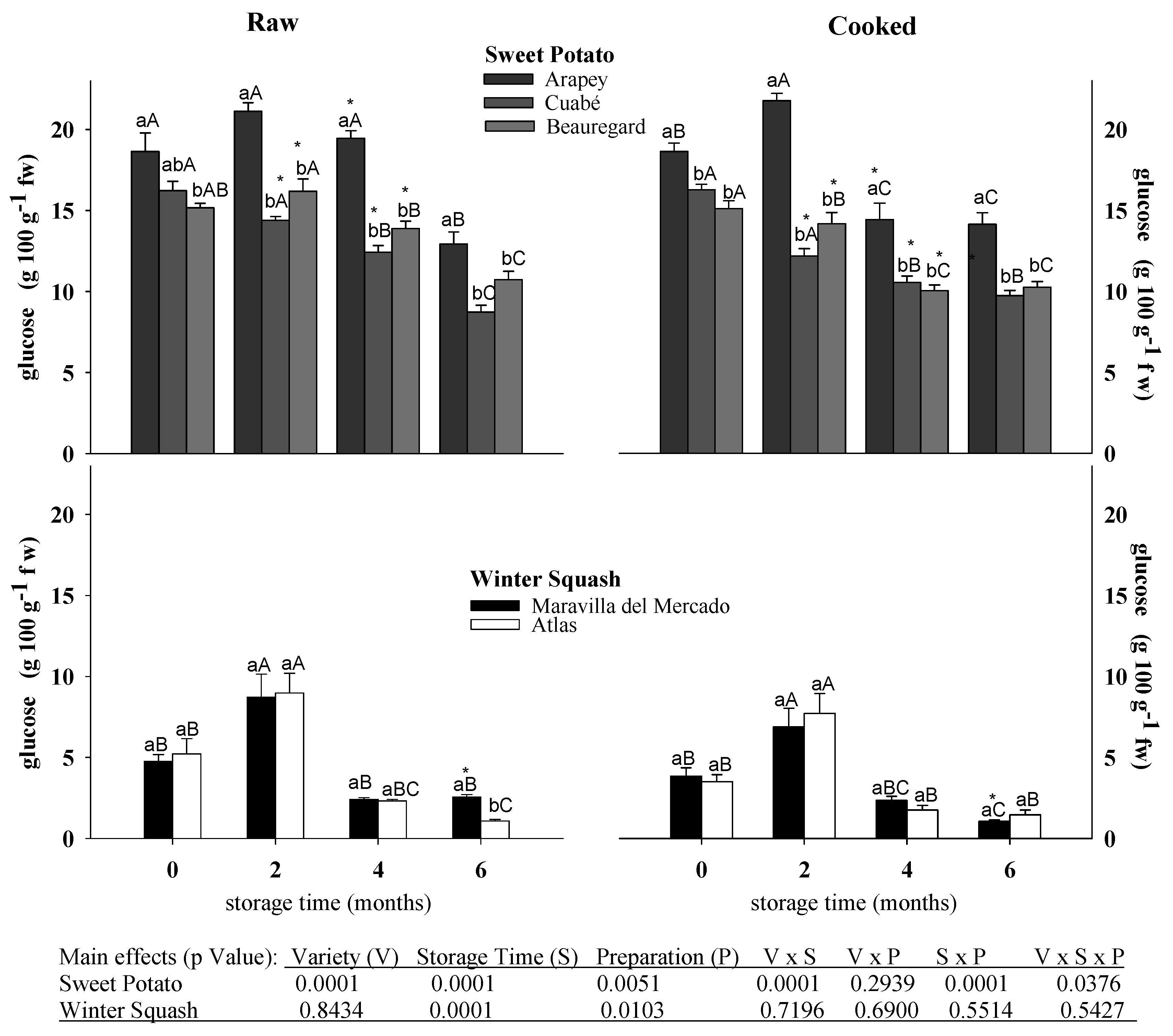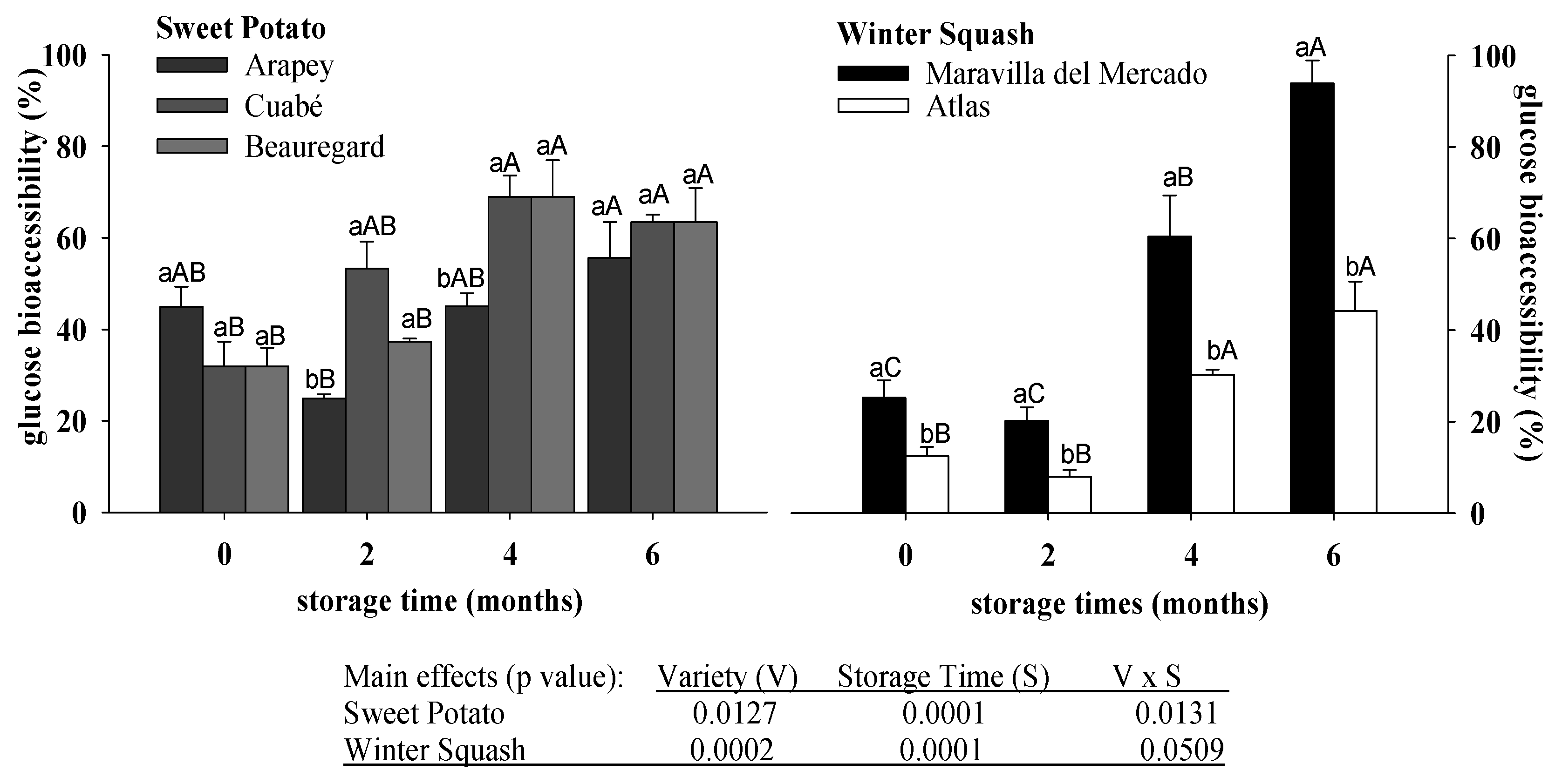Glucose Content and In Vitro Bioaccessibility in Sweet Potato and Winter Squash Varieties during Storage
Abstract
:1. Introduction
2. Experimental Section
2.1. Plant Materials and Sample Preparation
2.2. Total Glucose Content in Raw and Cooked Pulp
2.3. In Vitro Digestion of Cooked Pulp
2.4. In Vitro Bioaccessible Glucose Content in Cooked Pulp
2.5. Experimental Design and Statistical Analysis
3. Results and Discussion
3.1. Total Glucose Content in Raw and Cooked Pulp
3.2. In Vitro Bioaccessible Glucose Content in Cooked Pulp
4. Conclusions
Acknowledgments
Author Contributions
Conflicts of Interest
References
- FAO. Statistical Databases FAOSTAT. 2014. Available online: http://faostat.fao.org/es/#data/QC (accessed on 26 June 2016).
- Lim, T.K. Cucurbita Moschata. Available online: http://link.springer.com/chapter/10.1007/978-94-007-1764-0_41#page-2 (accessed on 20 March 2016).
- Bates, D.M.; Robinson, R.W.; Jeffrery, C. Biology and Utilization of the Cucurbitaceae, 1st ed.; Cornell University Press: Ithaca, NY, USA, 1990; p. 485. [Google Scholar]
- Woolfe, J. Sweet Potato: An Untapped Food Resource, 1st ed.; Cambridge University Press: New York, NY, USA, 1992; p. 643. [Google Scholar]
- Brücher, H. Carbohydrates from Roots and Tubers. In Useful Plants of Neotropical and Their Wild Relatives; Springer: Berlin/Heidelberg, Germany, 1989. [Google Scholar]
- La Bonte, D.L.; Picha, D.R.; Hester, A.; Johnson, H.A. Carbohydrate-Related Changes in Sweetpotato Storage Roots during Development. J. Am. Soc. Hortic. Sci. 2000, 125, 200–204. [Google Scholar]
- Zhang, Z.; Christopher, C.; Wheatley, C.C.; Corke, H. Biochemical changes during storage of sweet potato roots differing in dry matter content. Postharvest Biol. Technol. 2000, 24, 317–325. [Google Scholar] [CrossRef]
- Senanayake, S.; Gunaratne, A.; Ranaweera, K.D.S.; Bamunuarachchi, A. Effect of heat-moisture treatment on digestibility of different cultivars of sweet potato (Ipomea batatas (L.) Lam) starch. Food Sci. Nutr. 2014, 2, 398–402. [Google Scholar] [CrossRef] [PubMed]
- Kami, D.; Muro, T.; Sugiyama, K. Changes in starch and soluble sugar concentrations in winter squash mesocarp during storage at different temperatures. Sci. Hortic. 2011, 127, 444–446. [Google Scholar] [CrossRef]
- K’osambo, L.M.K.; Carey, E.E.; Misra, A.K.; Wilkes, J.; Hagenimana, V. Influence of Age Farming Site and Boiling on Pro-Vitamin A content in Sweet Potato (Ipomoea batatas (L.) Lam) Storage Roots. J. Food Compost. Anal. 1998, 11, 305–321. [Google Scholar] [CrossRef]
- Picha, D.H. Chilling injury, respiration and sugar changes in sweet potatoes stored at low temperature. J. Am. Soc. Hortic. Sci. 1987, 112, 497–502. [Google Scholar]
- Smith, M.A.; Riby, L.M.; Foster, J.K. Glucose enhancement of human memory: A comprehensive research review of the glucose memory facilitation effect. Neurosci. Biobehav. Rev. 2011, 35, 770–783. [Google Scholar] [CrossRef] [PubMed]
- Ruby, L.M.; Law, A.S.; McLaughlin, J.; Murray, J. Preliminary evidence that glucose ingestion facilitates prospective memory performance. Nutr. Res. 2011, 31, 370–377. [Google Scholar] [CrossRef] [PubMed]
- Peters, A.; Schweiger, U.; Pellerin, L.; Hubold, L.; Oltmanns, K.M.; Conrad, M.; Schultes, B.; Born, J.; Fehm, H.L. The selfish brain: Competition for energy resources. Neurosci. Biobehav. Rev. 2004, 28, 143–180. [Google Scholar] [CrossRef] [PubMed]
- European Food Safety Authority (EFSA). Scientific Opinion on Dietary Reference Values for Carbohydrates and Dietary Fiber. EFSA J. 2010, 8, 1–77. [Google Scholar] [CrossRef]
- Giménez, G.; González, M.; Rodríguez, G.; Vicente, E.; Vilaró, F. Catálogo de Cultivares Hortícolas 2014. Available online: http://www.ainfo.inia.uy/digital/bitstream/item/4590/1/Catalogo-cultivares-horticolas-2014.pdf (accessed on 15 March 2015).
- Zaccari, F.; Cabrera, M.C.; Ramos, A.; Saadoun, A. In vitro bioaccessibility of β-carotene. Ca, Mg and Zn in landrace carrots (Daucus carota. L.). Food Chem. 2015, 166, 365–371. [Google Scholar] [CrossRef] [PubMed]
- Takahata, Y.; Noda, T.; Sato, T. Changes in carbohydrates and enzyme activities of sweet potato lines during storage. J. Agric. Food. Chem. 1995, 43, 1923–1929. [Google Scholar] [CrossRef]
- Corrigan, V.K.; Irving, D.E.; Potter, J.F. Sugars and sweetness in buttercup squash. Food. Qual. Prefer. 2000, 11, 313–322. [Google Scholar] [CrossRef]
- Picha, D.H. Carbohydrates changes in sweet potatoes during curing and storage. J. Am. Soc. Hortic. Sci. 1987, 111, 89–92. [Google Scholar]
- Jiang, Y.; Chan, C.; Tao, X.; Wang, I.; Zhang, Y. A proteomic analysis of storage stress responses in Ipomoea batatas (L.) Lam. Tuberous root. Mol. Biol. Rep. 2012, 39, 8015–8025. [Google Scholar] [CrossRef] [PubMed]
- Shekhar, S.; Mishra, D.; Buraohain, A.K.; Charkraborty, S.; Charkaborty, N. Comparative analysis of phytochemicals and nutrient availability in two contrasting cultivars of sweet potato (Ipomoea batatas L.). Food Chem. 2015, 173, 957–965. [Google Scholar] [CrossRef] [PubMed]
- Zhang, T.; Oates, C.G. Relationship between α-amylase degradation and physicochemical properties of sweet potato starches. Food Chem. 1999, 65, 157–163. [Google Scholar] [CrossRef]
- Stevenson, D.G.; Yoo, S.-H.; Hurst, P.L.; Jane, J.-L. Structural and physicochemical characteristics of winter squash (Cucurbita maxima D.) fruit starches at harvest. Carbohydr. Polym. 2005, 59, 153–163. [Google Scholar] [CrossRef]
- McGillivray, J.H. Soluble solids content of different regions of watermelons. Plant Physiol. 1947, 22, 637–640. [Google Scholar] [CrossRef]
- Scott, G.W.; MacGillivray, J.H. Variation solids of the juice from different regions in melon fruits. Hilgardia 1940, 13, 69–79. [Google Scholar] [CrossRef]
- Trancoso-Reyes, N.; Ochoa-Martinez, L.A.; Bello-Perez, L.A.; Morales-Castro, L.; Estevez-Santiago, R.; Olmedilla-Alonso, B. Effect of pre-treatment on physicochemical and structural properties, and the bioaccessibility of beta-carotene in sweet potato flour. Food Chem. 2016, 200, 199–205. [Google Scholar] [CrossRef] [PubMed]
- Aina, A.J.; Falade, K.O.; Akingbala, J.O.; Titus, P. Physicochemical Properties of Caribbean Sweet Potato (Ipomoea batatas (L.) Lam) Starches. Food Bioprocess Technol. 2012, 5, 576–583. [Google Scholar] [CrossRef]
- Lai, Y.C.; Huang, C.L.; Chan, C.F.; Lien, C.Y.; Liao, W.C. Studies of sugar composition and starch morphology of baked sweet potatoes (Ipomoea batatas (L.) Lam). J. Food Sci. Technol. 2013, 50, 1193–1199. [Google Scholar] [CrossRef] [PubMed]
- Mennah-Govela, Y.A.; Bornhorst, G.M. Acid and moisture uptake in steamed and bolied sweet potatoes and associated structure changes during in vitro gastric digestion. Food Res. Int. 2016, 88, 247–255. [Google Scholar] [CrossRef]
- Moghissi, E.S.; Mary, T.; Korytkowski, M.T.; DiNardo, M.; Einhorn, D.; Hellman, R.; Hirsch, I.B.; Inzucchi, S.E.; Ismail-Beigi, F.; Kirkman, M.S.; et al. American Association of Clinical Endocrinologists nad American Diabetes Association consensus statement on in patient glycemic control. Endocr. Pract. 2009, 15, 353–369. [Google Scholar] [CrossRef] [PubMed]
- Institute of Medicine (IOM). Dietary Reference Intakes for Energy, Carbohydrate, Fiber, Fat, Fatty Acids, Cholesterol, Protein, and Amino Acids; National Academies Press: Washington, DC, USA, 2001; p. 1319. [Google Scholar]


| Storage Time (Months) | Sweet Potato | Winter Squash | |||
|---|---|---|---|---|---|
| Arapey | Beauregard | Cuabé | Maravilla del Mercado | Atlas | |
| 0 | 8.4 ± 1.0 | 5.1 ± 0.8 | 5.2 ± 0.8 | 1.1 ± 0.03 a,B | 0.5 ± 0.07 b,A |
| 2 | 5.6 ± 0.3 | 5.3 ± 0.4 | 6.5 ± 0.6 | 1.4 ± 0.06 a,A | 0.4 ± 0.05 b,A |
| 4 | 6.5 ± 0.6 | 7.5 ± 1.4 | 7.3 ± 0.6 | 1.3 ± 0.01 a,A,B | 0.7 ± 0.07 b,A |
| 6 | 7.7 ± 0.6 | 6.0 ± 0.7 | 6.2 ± 0.2 | 1.1 ± 0.09 a,B | 0.8 ± 0.12 a,A |
| Main Effects (p value): Variety (V) Storage Time (S) V × S | |||||
| Sweet Potato 0.1205 0.1958 0.0676 | |||||
| Winter Squash 0.0001 0.0542 0.0032 | |||||
© 2017 by the authors. Licensee MDPI, Basel, Switzerland. This article is an open access article distributed under the terms and conditions of the Creative Commons Attribution (CC BY) license (http://creativecommons.org/licenses/by/4.0/).
Share and Cite
Zaccari, F.; Cabrera, M.C.; Saadoun, A. Glucose Content and In Vitro Bioaccessibility in Sweet Potato and Winter Squash Varieties during Storage. Foods 2017, 6, 48. https://doi.org/10.3390/foods6070048
Zaccari F, Cabrera MC, Saadoun A. Glucose Content and In Vitro Bioaccessibility in Sweet Potato and Winter Squash Varieties during Storage. Foods. 2017; 6(7):48. https://doi.org/10.3390/foods6070048
Chicago/Turabian StyleZaccari, Fernanda, María Cristina Cabrera, and Ali Saadoun. 2017. "Glucose Content and In Vitro Bioaccessibility in Sweet Potato and Winter Squash Varieties during Storage" Foods 6, no. 7: 48. https://doi.org/10.3390/foods6070048





